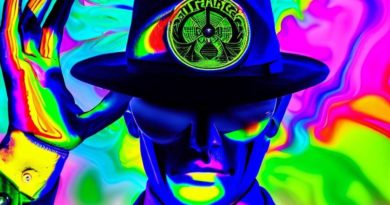Unabomber: Troubled Life of a CIA Mind Control Victim

Photograph Source: Lord Jim – CC BY 2.0
He was once a mathematician, a boy who earned a full scholarship and gained admission to Harvard University. Throughout his higher education, he excelled academically and displayed a remarkable intellect. However, as time passed, he grew disillusioned with the detrimental impact that state and private institutions were inflicting upon society. This frustration led him to abandon his previous life and develop a deep-seated hatred for the destruction of society and natural resources caused by modern technologies. In his anguish, he turned to violence, becoming a lone wolf who terrorized the United States of America for approximately 17 years. Operating from his forest cabin in Montana, he managed to detonate around 16 mail bombs.
To halt his campaign of bombings, he orchestrated a plan that involved the New York Times and the Washington Post publishing his extensive essay titled “Industrial Society and Its Future,” consisting of thirty-five thousand words. The newspapers complied with his demand, and following the publication, the series of attacks ceased. However, his brother eventually reported him to the authorities, leading to his arrest and the conclusion of what became the FBI’s most expensive operation in history.
Recently, Theodore (Ted) Kaczynski, also known as the “Unabomber,” passed away in prison at the age of 81. US authorities ruled his death a suicide. Understanding the life of Kaczynski is significant, as it offers valuable insights into the intricate relationship between the open state, the deep state, and the public. He vehemently despised cowardly and opportunistic leftists. In addition to studying major social transformations throughout history, he fearlessly wrote about them, providing a unique perspective.
Kaczynski once noted, “If you claim that the French and Russian revolutions failed, you might face objections. Most revolutions have two objectives: the destruction of the old society and the establishment of a new social model envisioned by the revolutionaries. Fortunately, the French and Russian revolutionaries achieved the former but failed to create the new societies they dreamt of. They were highly successful in dismantling the old order, though. We should have no illusions about the possibility of constructing a new and ideal form of society. But many so-called revolutions solely aim to destroy the existing society.” Through numerous articles published under various anonymous names, he extensively analyzed a wide range of social, political, and economic issues.
It is an extraordinary occurrence for someone to enter Harvard at the age of 16, pursue a career as a mathematics professor, and then abruptly abandon everything to become a terrorist. Before delving further into Kaczynski’s life, it is crucial to consider the social and political landscape of the time he lived in and when he attended Harvard.
This period marked five years since the end of World War II. Nazi Germany had been defeated, and countries like Japan and Italy, former adversaries of the Western Alliance, began aligning themselves with Western nations. Meanwhile, the United States administration focused on a separate project: undermining the power of the Soviet Union led by Joseph Stalin. Stalin had supported the Allies during the war, aiding in Germany’s defeat and the conclusion of the global conflict, and now the US sought to establish unipolarity.
To achieve this complex objective, the United States targeted various segments of American society, initiating different sub-projects that later came to be known as the Cold War. It was crucial to experiment with the populace to fortify the state’s structure and maintain its position as the world’s superpower. The primary emphasis centered on manipulating people’s minds to fulfill the deep state’s objectives. Though these events might seem like elements from a work of fiction, they were conducted in the research laboratories of numerous institutions across the United States of America, incurring substantial costs.
Some of these projects were later declassified, although heavily censored, in documents released by the CIA for public access. One of the well-known programs was MK-Ultra, a research program conducted by the CIA’s Office of Scientific Intelligence, focusing on mind control and chemical manipulation. Through this project, the world was confronted with the disturbing reality of the US administration, which, despite its professed values of individual liberty, human dignity, and human rights, engaged in inhumane actions to maintain its power. The Deep State, the true enabler of the US administration, was revealed to be involved in these unethical activities. Tragically, some of America’s brightest college students became unwitting victims of these experiments, leading to severe consequences for their lives.
Established in the early 1950s with official government sponsorship, MK-Ultra continued until at least the late 1960s and involved the use of unsuspecting US citizens as test subjects. Ted Kennedy spoke to Congress in 1977 about this abhorrent research, stating, “According to information disclosed by the Deputy Director of the CIA, more than thirty institutions, including universities, were involved in this ‘extensive testing and experimentation’ program, which included members from all walks of life, representing both natives and foreigners. Secret drugs were administered and used for investigations.”
In a series of chilling experiments, human subjects were subjected to the administration of the potent psychoactive drug LSD, disregarding their well-being entirely. Dr. Frank Olson, a participant in these disturbing investigations, met a tragic fate, officially deemed a suicide by authorities. The Rockefeller Commission, tasked with examining related activities, acknowledged the death of an unidentified doctor but remained silent about Olson. Later disclosures revealed that Olson had been forcibly given LSD. President Ford extended a government apology to Olson’s family for this heartrending tragedy. The CIA admitted the illegal nature and scientific insignificance of much of the research conducted under Project MK-Ultra. Adding to the alarm, those overseeing these experiments lacked proper scientific qualifications. Disturbingly, CIA Director Richard Helms ordered the destruction of a significant portion of information and evidence associated with the studies, hindering subsequent investigations. As a result, crucial information was lost in these inhumane experiments, leaving the Church and Rockefeller committees with insufficient evidence to formulate necessary conclusions and recommendations.
Notably, Harvard University was among the institutions implicated in these experiments carried out across over thirty government institutions and universities. Dr. Henry A. Murray, who had provided psychoanalysis on Adolf Hitler to the CIA’s predecessor, the Office of Strategic Services (OSS), led the project at Harvard. In 1950, Murray spearheaded a three-year series of experiments involving a group of Harvard psychologists. The aim of the research, akin to other projects, was to clandestinely explore the use of drugs and other techniques to manipulate individual mental states and modify brain function. Unbeknownst to him, Ted Kaczynski was one of twenty-two Harvard undergraduate students subjected to these mind manipulation experiments.
While Kaczynski, who hailed from a Polish descent family that resettled in the United States, claimed during the trial that his mind was not affected by the research, many researchers who were investigated regarding these unethical secret experiments expressed differing opinions. Alston Chase, a Harvard University graduate who extensively studied and wrote the book “Harvard and the Unabomber: The Education of an American Terrorist,” concluded that Kaczynski and his classmates were unwitting victims of Murray’s unethical research methods. They were subjected to experiencing emotions such as sadness, sexual fantasies, lust for power, uncontrollable anger, and pain.
As a consequence of these experiments, individuals were inevitably susceptible to radicalization and violence. Therefore, accountability should not only rest on Murray and his team but also on the CIA, the sponsor of their inhumane and undemocratic research. It is undeniable that the organization’s crimes may have contributed to various mental disorders. Ted Kaczynski, later branded as a ‘domestic terrorist,’ stands as another unfortunate example of how the deep state has subverted the positive attributes and public duties of the legitimate state, exploiting them for its own agenda.
Whether Kaczynski could have employed different methods and strategies to convey his message is a separate argument. However, the facts he presented in his writings have gained increasing relevance over time. The most disconcerting reality lies in the unknown and incalculable impact that loners like Kaczynski, who spend years attempting to effect societal change through the dissemination of profound political ideas alongside acts of violence, leave behind upon their death. Is it possible to prevent the remnants of such individuals, who are perceived as “evil criminals” by society, from manifesting in different ways and sprouting in different individuals? This question raises profound concerns.
This article has been archived for your research. The original version from CounterPunch can be found here.


